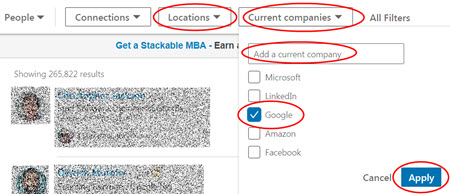
While only 7% of applicants are referred for jobs by an employee, 40% of new hires were referred!
On the other hand, only 12% (or less) of jobs are filled via job boards.
Where are you spending most of your job search time and effort?
Nearly 80% of employers with 1,000 employees or more have a formal employee referral program (ERP).
An employee referral programs is an increasingly popular form of recruiting that encourages, and often rewards, an organization’s current employees for referring a friend, a former colleague, or even a family member (maybe) for a job opening.
What Are Employee Job Referral Programs?
Employee referral programs are a formal process for recruiting new employees by encouraging and rewarding their current employees’ networks. As described below, how the programs work can differ greatly depending on the employer. They are definitely not all the same!
Explanation: How Employee Referral Programs Work
All participants benefit from the referrals:
- Job seekers LOVE employee referral programs! Employee referral programs really are the quickest way to get hired — 29 days to be hired via a referral vs. 39 days (or much longer) other ways.
- EmployEES LOVE employee referral programs. They often receive a financial reward, which can be in the thousands of dollars (depending on the ERP and the job) for helping a friend land a new job.
- EmployERS LOVE employee referral programs! The job candidates hired through employee referrals are usually successful employees who stay longer than average. Best, top performing employees typically refer other top performers.
The employee who makes the referral usually receives a financial reward, typically between $1,000 and $6,000, so employees are usually interested in finding good candidates to refer.
When/if that person is hired and performs acceptably in the job for at least 90 days (usually), the referring employee typically receives a financial reward. Sometimes, part of the award is is given to the referring employee when the new employee is hired and the balance after a pre-defined period of successful performance by the new employee.
Know the Program Rules for Your Target Employers!
Biggest mistake: Do NOT assume that you know how an employer’s program works! Applying the wrong way or at the wrong time can eliminate you from consideration permanently!
Referral programs typically have rules about when and how the employee earns the referral fee. Usually, the referral should happen before you apply for the job or during the job application process, as described below.
Understanding the program’s rules, and complying with them are essential for success.
So, check the ERP rules on the employer’s website — if the information is available — before you reach out to an employee.
If you can’t find the ERP rules on the employer’s website, then you will need to ask the employee to look for the program’s documentation which may be on the “intranet” (internal, employee-only website) or available through the HR organization.
Applying without complying with the employer’s rules can permanently end your ability to use that employer’s employee referral program.
Look for the employer’s policy on each of these criteria:
-
Timing of the referral.
CAREFUL! You can be disqualified for the ERP if you apply at the wrong time in the application process!
Some programs want the employee to refer you before you apply for the job, or, in some cases, before you register on their website.
Others allow the referral to happen after you have officially applied for the job.
-
Who can make a referral.
A hiring manager cannot typically refer someone, especially not for their own department. People in HR and recruiting are usually not able to refer a candidate, either.
-
Who can be referred.
Some employers prefer not to have an employee refer a relative.
-
Which jobs qualify for the reward.
Typically, the jobs that are in the ERP — or pay the best reward — are the jobs that are the hardest to fill, like jobs that are senior or jobs that are hard to fill because qualified candidates are scarce. So, not every job may be included.
-
Which location may qualify for the reward.
Some locations have a plentiful supply of job candidates, which means no — or a minimal — reward is offered by the employer. So, location and job matter.
Life is never simple these days. Be sure to understand the rules each employer has for their ERP program so you can be that referred candidate.
Proceed VERY Carefully — Don’t Disqualify Yourself by Breaking the ERP Program’s Rules.
While the basic elements are the same, each employer has their own approach to the process, and every program is different!
The very act of applying before being officially referred may disqualify you for some programs, depending on the rules of that particular program.
You may need to have the employee first register you as their referral, and then you can apply as a referred candidate. Or, you may be able to apply and then be referred. Qualifying depends on the requirements of the program (more below).
Employee referral programs for large employers operate two main ways:
1. Referral as part of the automated job application.
When you complete an online application for the job, you provide the name and contact information of the employee referring you.
There will probably be a section specifically for employee referrals (usually in the how-did-you-find-out-about-this-job section). Or, you may need to type the referring employee’s contact information into another section.
2. Referral form submitted by the referring employee (before OR after the application).
The employee who is referring you submits a form officially referring you. Some employers require that the referral form be submitted before you apply for a job. Others accept the referral at any time. It depends on the employer’s rules.
In many cases, they don’t need to specify the job you are applying for. Other times, they do. Again, it depends on the employer.
After their form is accepted, you are typically notified of the referral, and invited to look at the jobs and apply.
With smaller employers that may not have automated referral systems, the process will be different. The employee doing the referral may simply hand your resume to the hiring manager or Human Resources manager.
Making an Employer’s Referral Program Work for You
When you have a contact at a target employer, ask the employee to send you the rules for their employer’s program. Then, make sure that you both comply with those rules to make the referral (and the reward to the employee) happen the most easily.
I recently heard from a job seeker who had a friend send them a link to a job with the friend’s employer. The job seeker immediately applied for the job and immediately disqualified himself from the employee referral program because — for that employer — the application was supposed to come through the employee. OOPS!
If someone has offered to refer you, be sure you have shared contact information, like this:
- Their name at work (you may know her as Debbi, but at work everyone calls her Debra).
- Work email address.
- Their department/division or office.
- Their location.
- Their job title.
- Their work phone number.
Also, be sure to provide the employee with:
- Your name (as used on your job applications, resumes, LinkedIn profile, etc.).
- Your personal (not work!) email address.
- Your personal (not work!) phone number.
- A copy of your resume.
You must both be sure that you have the information you need to complete the process successfully. You want this person to be rewarded for their kindness, and you also want the advantage that comes from being a referred candidate.
Finding the People Who Can Refer You
Today, connecting with people who can refer you is much easier than in the past. That’s the good news and, sometimes, the bad news.
Rather than making a bunch of phone calls or trying to track down email addresses, Google and social media are excellent resources for finding contacts.
Have Target Employers
Start with your target employers:
- Employers with reputations as good places to work.
- Employers in the “right industry” for you.
- Employers which are the “right size” for you.
- Employers in the best location for you.
Asking random people to make a referral doesn’t usually work well. You could end up finding a job with an employer which is close to going out of business, and being unfocused usually makes the whole process take longer.
Start with LinkedIn
If you search through the jobs on LinkedIn, it will show you any connections you have to the employer along with the job posting. Then, you can reach out to them via LinkedIn without needing to do any additional research.
If you are not applying for a job through LinkedIn, you will still find it handy for identifying people who work at your target employers.
Type a company name into the search box at the top of most LinkedIn pages. Click on the word “People” above the initial search results, and LinkedIn will show you people who are 1st, 2nd, and 3rd level connections working for that employer.
Then, to find current employees, “filter” the results by “Current companies” for employers on your target employer list, as shown below. Choose your target location and LinkedIn also allows you to specify the level of connection (1st, 2nd, or 3rd).
To find former employees (who probably still have contacts at the target employer), click on the “All Filters” link to “filter” the results by “Past companies.”
Then, look for contact information that enables you to reach out. If there is no contact information, try a Google search on the person’s name plus the term “email address.”
For example, if you wanted to reach someone named Mary Jane Smith, you would do this search on Google — “mary jane smith” “email address” — and hopefully Google would find a web page with contact information on it.
Check out Job-Hunt’s Guide to LinkedIn for Job Search for much more information.
Check Your Facebook Connections
Like LinkedIn, Facebook also offers a “People” search capability. The most effective searches are accomplished by simply typing:
- people who work at [company name] OR
- people who worked at [company name]
As with LinkedIn, check the person’s Facebook account to see if they have included their email address in the About – Contact and Basic Info section of their profile. If you don’t find contact information, try the Google search described above.
Check out Job-Hunt’s Guide to Facebook for Job Search for more information about using Facebook for a successful job search.
Leverage Informational Interviews to Find More People (and Inside Information)
Informational interviews can be a gold mine for collecting information about employers, jobs, and also for learning about additional people to contact. With a good relationship with any of these contacts, you can likely receive a referral. See Job-Hunt’s Guide to Informational Interviews for more information about successful informational interviews
Sample Email Messages — Reach Out Carefully and Gracefully
Ideally, when you ask for a referral, the person you are asking is someone you know reasonably well. They are putting their credibility on the line by referring you, so they need to be comfortable that you would perform well in the job (and not embarrass them).
Do research in advance, if possible, to learn how their employer’s referral program works.
Employee Referral Program requirements vary widely! So, don’t make assumptions!
You also don’t want to put the relationship at risk, and, particularly if you haven’t been in touch for a while, you also want to catch up with what’s going on in their lives a bit, too.
The examples, below, could be an initial message to the person who might be able to refer you. Be sure to send from your non-work email address.
Replace the content in brackets, [like this] with the information described to use for your message. Or, simply use the ideas in these examples to create your own messages.
An email message to a former co-worker:
Subject: Possibly job referral?
Hi [first name of the employee],
How are you doing? Hope all is going well for you and your family!
It’s been a few years since we worked together at [employer name], but I’m hoping you remember those times as positively as I do.
Currently, I am working as a [your current job title] for [your current employer] and feel that it is time to move on. Your employer, [name of their current employer], interests me as a great place to work. I’ve been reading about [product or service name or other positive information] and am excited at the possibility of joining the organization.
If possible, I would greatly appreciate having you refer me for the job linked below [or the specific job title].
I understand from the information available on the company website that there is an employee referral program which means you may receive a reward for referring me. So, both of us will benefit if this works.
This is the position that interests me — [copy the URL from the top of the browser where the job is displayed, like this: https://www.job-hunt.org/... for this article].
I’d be happy to email you a copy of my resume, and you can check out my LinkedIn Profile here — [URL of your Profile, like this: https://www.linkedin.com/in/yourname] — to see if you would be comfortable referring me for this position.
Let me know how to proceed. Should I apply directly and include your name, or do you need to forward my resume to someone.
I’d be very grateful for any assistance you can provide and happy to reciprocate if there is anything I can help you with. Hopefully, this will work out well for both of us.
Best regards,
[Your first name]
[Your full name]
[Job title or branding statement]
[Non-work phone number]
[LinkedIn Profile URL]
An email message to a stranger with a referral from a contact:
Subject: Referral from [name of referrer]
Hi [first name of the employee],
[Name of referrer] highly recommends you as an excellent contact at [employer name].
Currently, I am working as a [your current job title] for [current employer], and it is time to move on. I’ve been reading about [product or service name or other positive information] and am excited at the possibility of joining your organization.
I am very interested in working at your company, in particular a position as a [your target job title]. I found an open position [include the job number or identifier on the job description] which I find very interesting.
I understand from the information available on the company website that there is an employee referral program which means you may receive a reward for referring me. So, both of us will benefit if this works. Excellent!
If possible, I would appreciate 10 minutes of your time for a brief talk about your experiences working there and, of course, the possibility of having you refer me for a job [or the specific job title].
I’d be happy to email you a copy of my resume, or you can check out my LinkedIn Profile here — [URL of your Profile, like this — https://www.linkedin.com/in/yourname].
Best regards,
[Your name]
[Your full name]
[Job title or branding statement]
[Non-work phone number]
[LinkedIn Profile URL]
Bottom Line on Employee Referral Job Applications
Employee referrals are a very effective way to land a job, but don’t assume that all employee referral programs are alike. It is too easy to mess up and disqualify yourself permanently for an employer’s program.
More About Employee Referrals:
- Find Jobs by Targeting Employers
- Get Sourced to Get Hired
- Email Requests for Informational Interviews
- Sample Thank You Note for a Referral
* Source of data in the article above:
- LinkedIn’s Ultimate List of Hiring Statistics.
- JobVite’s The Value of a Referral
- ERE.net’s 10 Compelling Numbers That Reveal the Power of Employee Referrals.

Online job search expert Susan P. Joyce has been observing the online job search world and teaching online job search skills since 1995. A veteran of the United States Marine Corps and a recent Visiting Scholar at the MIT Sloan School of Management, Susan is a two-time layoff “graduate” who has worked in human resources at Harvard University and in a compensation consulting firm. Since 1998, Susan has been editor and publisher of Job-Hunt.org. Follow Susan on Twitter at @jobhuntorg and on Facebook, LinkedIn.
More about this author…
Don't forget to share this article with friends!






